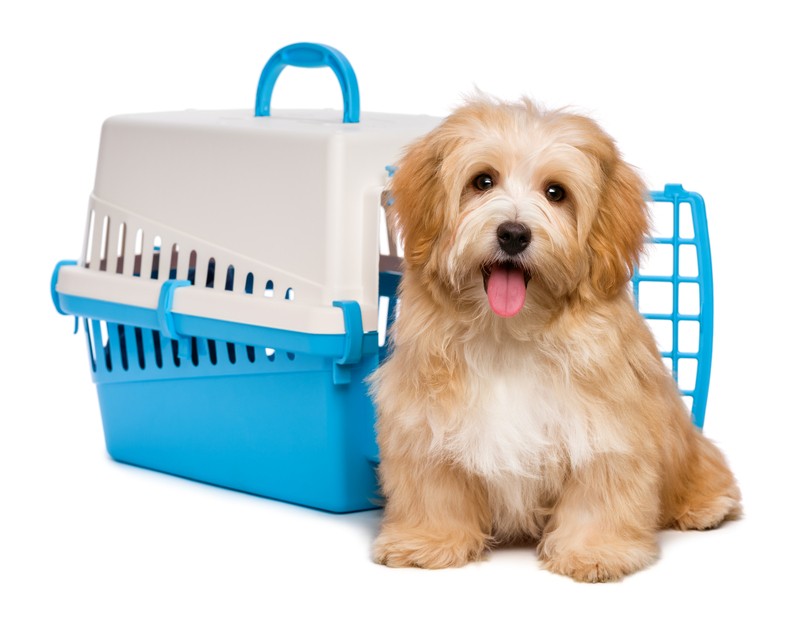The following are some clear and easy to understand steps you can implement while crate training your dog. The more you know the easier it will be!
Step 1: Introduce your dog to the crate
Place the crate in an area of your house where the family spends a lot of time, such as the family room. Put a soft blanket or towel in the crate. Take the door off and let the dog explore the crate at his leisure. Some dogs will be naturally curious and start sleeping in the crate right away.
Encourage your dog to enter the crate by dropping some small food treats nearby, then just inside the door, and finally, all the way inside the crate. If he refuses to go all the way in at first, that's okay; don't force him to enter.
Continue tossing treats into the crate until your dog will walk calmly all the way into the crate to get the food. If he isn't interested in treats, try tossing a favorite toy in the crate. This step may take a few minutes or as long as several days.Step 2: Feed your dog his meals in the crate
After introducing your dog to the crate, begin feeding him his regular meals near the crate. This will create a pleasant association with the crate.
If your dog is readily entering the crate when you begin Step 2, place the food dish all the way at the back of the crate.
If he remains reluctant to enter the crate, put the dish only as far inside as he will readily go without becoming fearful or anxious. Each time you feed him, place the dish a little further back in the crate.
Once your dog is standing comfortably in the crate to eat his meal, you can close the door while he's eating. The first time you do this, open the door as soon as he finishes his meal. With each successive feeding, leave the door closed a few minutes longer, until he's staying in the crate for ten minutes or so after eating.
If he begins to whine to be let out, you may have increased the length of time too quickly. Next time, try leaving him in the crate for a shorter time period. If he does whine or cry in the crate, don’t let him out until he stops. Otherwise, he'll learn that the way to get out of the crate is to whine, so he'll keep doing it.Step 3: Lengthen the crating periods
After your dog is eating his regular meals in the crate with no sign of fear or anxiety, you can confine him there for short time periods while you're home.
Call him over to the crate and give him a treat.
Give him a command to enter, such as “kennel.” Encourage him by pointing to the inside of the crate with a treat in your hand.
After your dog enters the crate, praise him, give him the treat, and close the door.
Sit quietly near the crate for five to ten minutes, and then go into another room for a few minutes. Return, sit quietly again for a short time, and then let him out of the crate.
Repeat this process several times a day, gradually increasing the length of time you leave him in the crate and the length of time you're out of his sight.
Once your dog will stay quietly in the crate for about 30 minutes with you mostly out of sight, you can begin leaving him crated when you're gone for short time periods and/or letting him sleep there at night. This may take several days or several weeks.Step 4, Part A: Crate your dog when you leave
After your dog can spend about 30 minutes in the crate without becoming anxious or afraid, you can begin leaving him crated for short periods when you leave the house.
Put him in the crate using your regular command and a treat. You might also want to leave him with a few safe toys in the crate.
Vary at what point in your “getting ready to leave” routine you put your dog in the crate. Although he shouldn't be crated for a long time before you leave, you can crate him anywhere from five to 20 minutes prior to leaving.
Don't make your departures emotional and prolonged—they should be matter-of-fact. Praise your dog briefly, give him a treat for entering the crate, and then leave quietly.
Now, just as a quick alert: Crate training will take some time and persistence. There will be initial mistakes while you and your dog get used to this new undertaking. Don’t expect your pet to miraculously know the rules over-night. However, with some patience and following the guide above your furry companion could eventually be a crate trained prodigy!
For more information on crate training and what type of crate might be best for your dog (and to also see a great video on crate training) go to The Humane Society‘s website!










